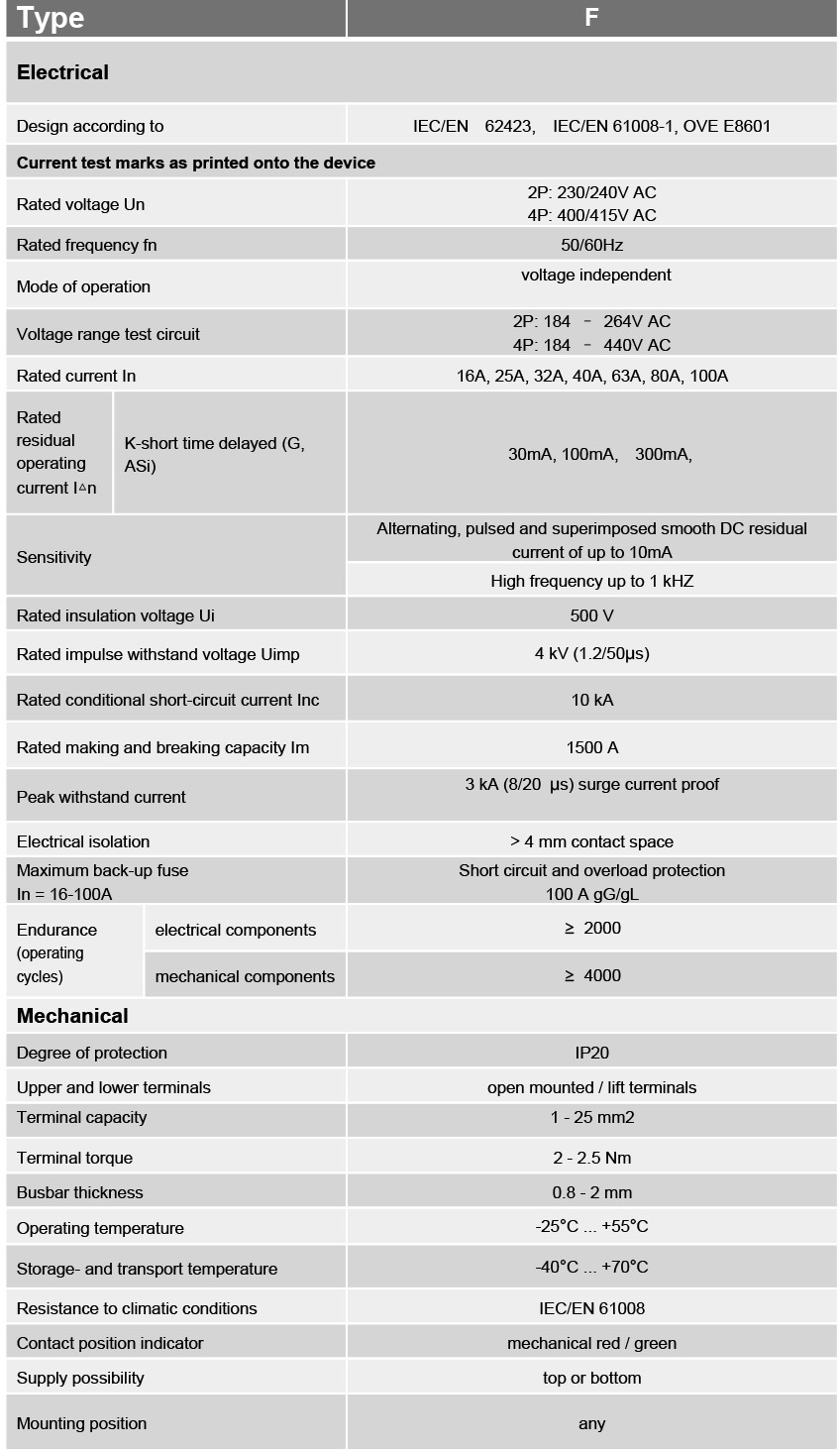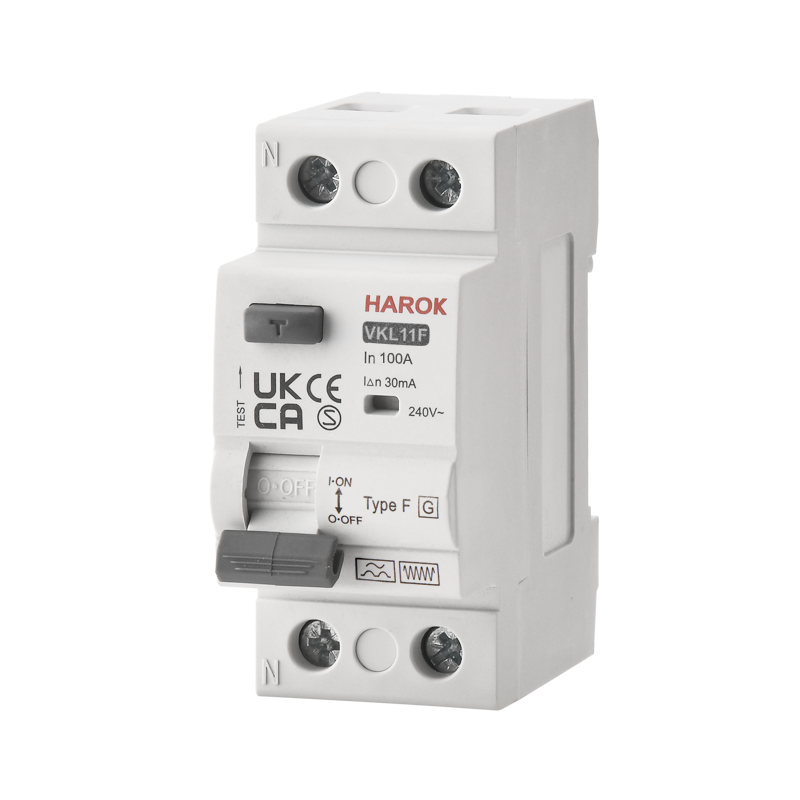Function VML01F Residual Current Circuit Breaker Type F(RCCB Type F) is appearance design, compact structure,good reliability, and high safety. The VML01F RCCB Type F is defined according to IEC/EN 62423. It provides safe and reli...
VKL11F
VKL11F Residual Current Operated Circuit Breaker (Magnetic) (Type F)
Design according to:IEC/EN 62423, IEC/EN 61008-1, OVE E8601
Current test marks as printed onto the device
Rated voltage Un:2P: 230/240V AC 4P: 400/415V AC
Rated frequency fn:50/60Hz
Mode of operation:voltage independent
Voltage range test circuit:2P: 184 – 264V AC 4P: 184 – 440V AC
Rated current In:16A, 25A, 32A, 40A, 63A,
Product Profile
Function
VKL11F Residual Current Circuit Breaker Type F(RCCB Type F) is appearance design, compact structure,good reliability, and high safety.
The VKL11F RCCB Type F is defined according to IEC/EN 62423. It provides safe and reliable protection against sinusoidal residual currents and pulsating DC fault currents (like type A devices). It is also capable of handling residual currents with mixed frequencies of up to 1 kHz (10, 50, 1000 Hz) in accordance with the IEC 62423 standard. Type F RCCB maintain the standard functionality with superimposed smooth DC residual currents of up to 10 mA without affecting their standard functionality(However, smooth DC fault currents cannot be detected).
VKL11F RCCB Type F have additionally short-time delayed compared to RCCB Type A, and distinguish themselves from other devices thanks to their high resistance to power surges(have an increased surge current resistance of 3,000 A, prevent unwanted trippings e. g. due to surge currents, thunderstorms or operational leakage currents and thus increase system availability): this ensures minimal false tripping and a high degree of safety. They are available as RCCBs (2-pole or 4-pole up to 100 A) . With three versions for different residual currents (30mA,100mA and 300 mA), the RCCB type F functionality is voltage independent and can be used for fault and additional protection.
Note:Washing machines, hoovers, dishwashers, vibrators, hammer drills, heating and heat pumps, ballasts in lighting systems, air conditioners and welding equipment are all appliances that are in daily use in industry and households. As electronic controllers are increasingly used in such devices, residual currents occur that cannot be adequately detected by a type A RCCB. The reason for this is obvious: single-phase frequency converters are being used more and more frequently to control the motor speed in order to make the devices more energy efficient. These frequency inverters can generate residual currents with mixing frequencies other than 50 Hz by outputting a variable frequency in the order of 10 to 400 Hz. As a result, a RCCB Type A may not trip properly in the event of a fault, because it is affected by these mixing frequencies. This would mean that the RCCB will not possibly trip even if a fault occurs in the 50 Hz range.
Advantage:
• Suitable for use with single-phase frequency inverters
• Sensitive to alternating and pulsating DC fault currents of the mains frequency (Type A)
• Meets all requirements for RCCBs Type A, so that this can be replaced 1:1 by Type F
• Functionality maintenance with superimposed smooth DC residual currents of up to 10 mA (instead of only 6 mA, as with Type A)
• Sensitive to alternating residual currents with mixing frequencies unequal to 50 Hz (up to 1 kHz)
• High immunity against surge fault currents and mains voltage driven follow-on current pulses up to 3 kA
• Short-time delay of up to 10 ms prevents unwanted triggering by transient leakage currents
• Thunderstorm proof
• Small size for all rated currents
• High short-circuit current resistance of 10 kA
Selection
Detectable wave form
Type F
Tripping is ensured for sinusoidal AC residual currents pulsed DC residual currents, alternating residual sinusoidal currents up to 1000Hz, maintain the standard functionality with superimposed smooth DC residual currents of up to 10 mA

Tripping sensitivity 30mA - additional protection against direct contact. 100mA - co-ordinated with the earth system according to the formula IΔn<50/R, to provide protection against indirect contacts; 300mA - protection against indirect contacts, as well as fire hazard. Tripping time Short time delay
Approvals and certificates: UKCA,CE
Technical Data

Dimensions

Product Profile
Function
VKL11F Residual Current Circuit Breaker Type F(RCCB Type F) is appearance design, compact structure,good reliability, and high safety.
The VKL11F RCCB Type F is defined according to IEC/EN 62423. It provides safe and reliable protection against sinusoidal residual currents and pulsating DC fault currents (like type A devices). It is also capable of handling residual currents with mixed frequencies of up to 1 kHz (10, 50, 1000 Hz) in accordance with the IEC 62423 standard. Type F RCCB maintain the standard functionality with superimposed smooth DC residual currents of up to 10 mA without affecting their standard functionality(However, smooth DC fault currents cannot be detected).
VKL11F RCCB Type F have additionally short-time delayed compared to RCCB Type A, and distinguish themselves from other devices thanks to their high resistance to power surges(have an increased surge current resistance of 3,000 A, prevent unwanted trippings e. g. due to surge currents, thunderstorms or operational leakage currents and thus increase system availability): this ensures minimal false tripping and a high degree of safety. They are available as RCCBs (2-pole or 4-pole up to 100 A) . With three versions for different residual currents (30mA,100mA and 300 mA), the RCCB type F functionality is voltage independent and can be used for fault and additional protection.
Note:Washing machines, hoovers, dishwashers, vibrators, hammer drills, heating and heat pumps, ballasts in lighting systems, air conditioners and welding equipment are all appliances that are in daily use in industry and households. As electronic controllers are increasingly used in such devices, residual currents occur that cannot be adequately detected by a type A RCCB. The reason for this is obvious: single-phase frequency converters are being used more and more frequently to control the motor speed in order to make the devices more energy efficient. These frequency inverters can generate residual currents with mixing frequencies other than 50 Hz by outputting a variable frequency in the order of 10 to 400 Hz. As a result, a RCCB Type A may not trip properly in the event of a fault, because it is affected by these mixing frequencies. This would mean that the RCCB will not possibly trip even if a fault occurs in the 50 Hz range.
Advantage:
• Suitable for use with single-phase frequency inverters
• Sensitive to alternating and pulsating DC fault currents of the mains frequency (Type A)
• Meets all requirements for RCCBs Type A, so that this can be replaced 1:1 by Type F
• Functionality maintenance with superimposed smooth DC residual currents of up to 10 mA (instead of only 6 mA, as with Type A)
• Sensitive to alternating residual currents with mixing frequencies unequal to 50 Hz (up to 1 kHz)
• High immunity against surge fault currents and mains voltage driven follow-on current pulses up to 3 kA
• Short-time delay of up to 10 ms prevents unwanted triggering by transient leakage currents
• Thunderstorm proof
• Small size for all rated currents
• High short-circuit current resistance of 10 kA
Selection
Detectable wave form
Type F
Tripping is ensured for sinusoidal AC residual currents pulsed DC residual currents, alternating residual sinusoidal currents up to 1000Hz, maintain the standard functionality with superimposed smooth DC residual currents of up to 10 mA

Tripping sensitivity 30mA - additional protection against direct contact. 100mA - co-ordinated with the earth system according to the formula IΔn<50/R, to provide protection against indirect contacts; 300mA - protection against indirect contacts, as well as fire hazard. Tripping time Short time delay
Approvals and certificates: UKCA,CE



